Tagged with 'London'


-
Central Saint Martins Jewellery 2014 - IV
Central Saint Martins Jewellery 2014 - IV
Here we feature the final part in our series of short interviews with designers from the Central Saint Martins Jewellery 2014 show, including in this article – Sylvia Zhang, Tresy Liaunardy, Vicky Lew, Yerin Jeon and Ying Lola Lou.
For the second year, we have been working with the students designers of the Central Saint Martins Jewellery Design course. We will be awarding a Winterson Prize to one of the students for 'The Best Use of Pearls' at Jewellery Awards Evening on 19th June.
Read about some of the other designers in Part I, Part II and Part III of our interviews here. Discover the Winner of the Winterson Prize 2014 here.
SYLVIA ZHANG
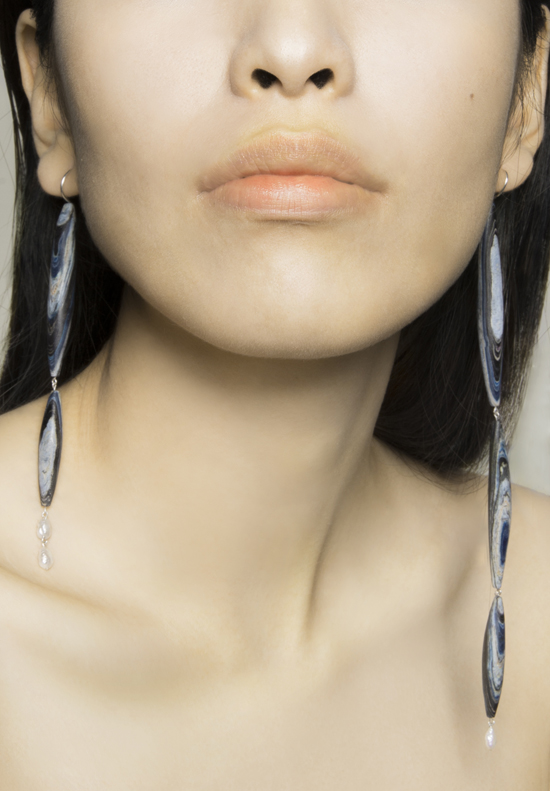
Tell us a little bit about yourself.
My name is Sylvia Zhang.
What was the inspiration for this collection?
The aesthetic of Taoism’s simplicity and the philosophy of worshipping nature.
What have you discovered about working with pearls?
Pearls have great possibilities and can work really well with different concepts.
What’s next for you after CSM?
I will be pursuing higher academic qualifications.
Which designer or artist do you most admire?
David Watkins.
Name one jewellery toolbox essential that you can’t live without.
My files in different grades.
Name your favourite place for design in London.
Tate Modern.
TRESY LIAUNARDY
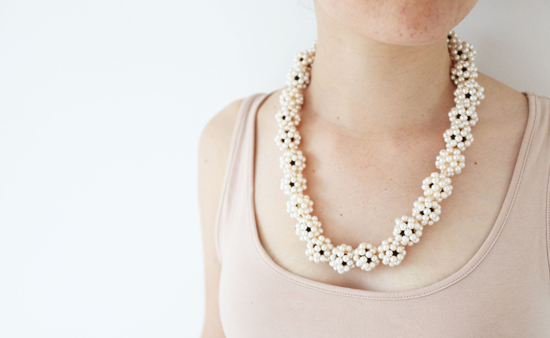
Tell us a little bit about yourself.
I am from Indonesia, I was introduced to the world of jewellery by my mother, because of her profession. I believe in handmade jewellery and the journey of making the piece itself.
What was the inspiration for this collection?
I was inspired by United Kingdom itself, which is a beautiful country with rich backgrounds and stories.
What have you discovered about working with pearls?
I have discovered that pearls are very versatile, the rich colour and lustre can be combined with any material.
What’s next for you after CSM?
I would like to learn more about fine jewellery making.
Which designer or artist do you most admire?
JAR: Joel A. Rosenthal.
Name one jewellery toolbox essential that you can’t live without.
My pin vice.
VICKY LEW

Tell us a little bit about yourself.
I am a Malaysian-born and bred girl. I grew up surrounded by shoes – Dad's a shoe designer and Mum's very lucky!
I initially planned to pursue a shoe design course but decided on jewellery instead (much to my Dad's amusement), just because I wanted to work on different parts of the body rather than just on the feet.
What was the inspiration for this collection?
My collection Flight was inspired by a photo I took of a bird in Hyde Park. It was spreading its wings before it flew away. It's such a lovely transient moment and I like to preserve such moment in pieces of jewellery.
What have you discovered about working with pearls?
The pearl has a luminescence that is unlike other gem, never failing to add a touch of luxury to any piece. A t-shirt will instantly look regal and elegant with pearls sewn into them.
What’s next for you after CSM?
Having my own studio would be nice.
Who could you imagine wearing your jewellery?
I'd like to see Tilda Swinton wearing my pieces.
What is it that makes a piece of jewellery a design classic?
A memorable one.
What is your most treasured piece of jewellery?
My gold baby ring, which I now wear as a pinky ring.
Which designer or artist do you most admire?
Gijs Bakker for his interpretation of jewellery, always unexpected and very clever.
Name one jewellery toolbox essential that you can’t live without.
My handy Dremel torch, it's also good for the occasional creme brulee.
Name your favourite place for design in London.
The Victoria and Albert Museum, I get inspired by different things each time I visit.
What’s your motto?
Perseverance is the key to success.
YERIN JEON
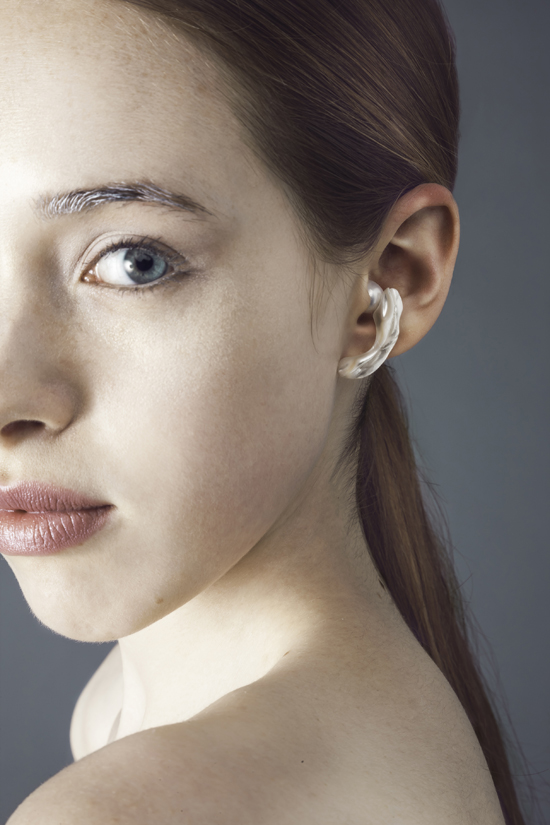
Tell us a little bit about yourself.
My name is Yerin Jeon, I come from South Korea. I studied fine arts in Germany and then came to London to study jewellery design at Central Saint Martins. I am a designer and a creative.
What was the inspiration for this collection?
Attempt to visualize the invisible. Especially the sound of silence, which is interpreted internally and externally in this collection.
Wearing the piece, from the other side, people can visually trace the flowing lines of resonance around body.
What have you discovered about working with pearls?
I researched more about how pearls are created and chose to focus on their shell, where they are formed.
I also looked at how pearls can function as a medium to allow sound to remain trapped within them. Furthermore, I was surprised to find out that when pearls are worn as earrings, they give a soft and comforting feeling.
What’s next for you after CSM?
I would perhaps like to work for a fashion brand because I am interested in how they accentuate the properties of textiles and the beauty of objects around us.
Which designer or artist do you most admire?
Francis Alÿs.
What’s your motto?
You create your opportunities by asking for them (Patty Hansen).
YING LOLA LOU

Tell us a little bit about yourself.
My name is Ying Lola Lou, born and raised in China. I am interested in observing the people, living things or anything that might catch my eye.
What was the inspiration for this collection?
The idea of this project is to turn my drawings into jewellery or wearable accessory pieces. This is my own way of capturing my memories.
The drawings are portraits of my friends, of hands holding or picking up a stone. As most of the pieces (with drawings on them) are quite flat, I am playing with the components, to add some other element such as branches cast from metal, pearls or wire frames that continue the drawing.
What have you discovered about working with pearls?
Pearls are not as fragile as I imagined they would be. And you can’t glue pearls onto the silk thread because the silk thread breaks apart after the glue dried.
What’s next for you after CSM?
I would like to learn about ceramics.
Which designer or artist do you most admire?
Salvador Dali.
Name one jewellery toolbox essential that you can’t live without.
My jewellery files.
-
Central Saint Martins Jewellery 2014 - III
Central Saint Martins Jewellery 2014 - III
Here we feature the third in a four part series of short interviews with designers from the Central Saint Martins Jewellery 2014 show, including in this article – Raven Tuson, Robyn Hole, Ruiyin Lin and Shirley Li.
For the second year, we have been working with the students designers of the Central Saint Martins Jewellery Design course. We will be awarding a Winterson Prize to one of the students for 'The Best Use of Pearls' at Jewellery Awards Evening on 19th June.
Read about some of the other designers in Part I, Part II and Part IV of our interviews here. Discover the Winner of the Winterson Prize 2014 here.
RAVEN TUSON

Tell us a little bit about yourself
I am always bursting with ideas and like to express these by trying out new materials and methods. I enjoy visiting museums and being creative by capturing inspiration from sketching and photography.
What was the inspiration for this collection?
The focus of this collection is the lifecycle of architectural structures and how, over time, they are transformed by the natural world. The collection aims to portray the stages of transition from cradle to grave, with the pieces representing a milestone in the buildings lifecycle.
Each stage is expressed through a varied use of materials with delicate lines of silver wire and chain representing the architectural structure and fine silver granules and a mixture of stones appearing as natural growths on the pieces.
What have you discovered about working with pearls?
Using pearls was a great way of introducing my work to using real life grown formations and offered my jewellery a natural element.
What’s next for you after CSM?
I intend to continue with designing and making, creating many more collections and building my own business.
What is your most treasured piece of jewellery?
The brooch as it collects all my significant elements in one piece.
Name one jewellery toolbox essential that you can’t live without?
My files as it allow me to create perfect angles for geometric effects.
ROBYN HOLE
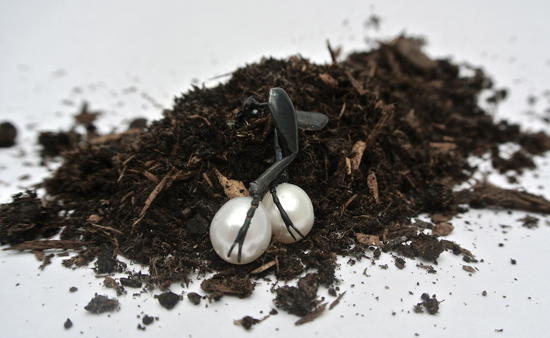
Tell us a little bit about yourself.
I have been designing /making jewellery for the past 3 years and I enjoy experimenting with materials and ideas. Finding a good concept keeps me interested and always thinking.
What was the inspiration for this collection?
The metamorphosis of a beetle was the inspiration for this collection.
What have you discovered about working with pearls?
I have learnt a lot about pearls during this project and I have learnt that silicone can be used as a vehicle to enhance small pearls and make them look bigger. I have also learnt that the lustre of the pearls is very important.
What’s next for you after CSM?
After CSM I would like to create my own business selling jewellery, I would like to explore further the use of pearls and silicone.
Which designer or artist do you most admire?
Vivienne Westwood, because she pushes boundaries more than most.
What’s your motto?
Anything is possible and everything happens for a reason.
RUIYIN LIN

Tell us a little bit about yourself.
I am drawn to the aesthetics of the past as a way of preserving our memories and I adore the new with its unknown future.
What was the inspiration for this collection?
I wanted to create a collection that is both a tribute to the past and a prelude to the future, to explore our intuitive comfort of the familiar by taking traditional forms and subverting them with contemporary attitude and techniques.
What have you discovered about working with pearls?
Pearls are so hardy it sometimes still surprises me. I’m in love with how pearls are formed.
Mixing modern materials with pearls allow me to create a bridge between the processes of construction. Layers of nacre form pearls, and 3D printing is a process that is likewise built in layers. I hope to question the perceived preciousness of these materials and their authenticity.
What’s next for you after CSM?
I’m hoping to set up a jewellery and furniture studio.
Name one jewellery toolbox essential that you can’t live without.
My hands.
What’s your motto?
Stay hungry, stay foolish. – Steve Jobs
SHIRLEY LI
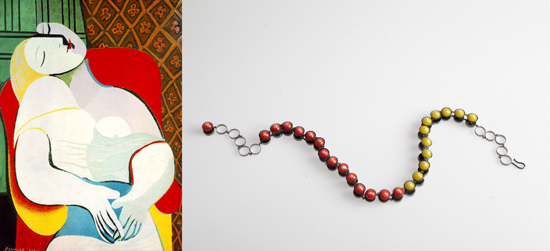
Tell us a little bit about yourself.
My name is Shirley Li. I am a jewellery design student at CSM, sick with design but I love art.
What was the inspiration for this collection?
The collection inspired by jewellery in famous oil paintings. I am trying to remake them and redefine their value.
What have you discovered about working with pearls?
It is a material that has lots of possibilities for use. Especially in my collection I made fake pearls with resin and wood. Mixing pearl powder in paints and using that to paint a new fake pearl. It is a process of deconstruction that redefines the value of pearl.
What is it that makes a piece of jewellery a design classic?
Full of designer’s love, a look that is simple outside and unique inside.
Name your favourite place for design in London.
No doubt, it is Central Saint Martins.
-
Central Saint Martins Jewellery 2014 - II
Central Saint Martins Jewellery 2014 - II
Here we feature the second in a four part series of short interviews with designers from the Central Saint Martins Jewellery 2014 show, including in this article – Gianna Pak Yung Chan, Ioanna Souflia, Jessie Seo and Junko Kurihara.
For the second year, we have been working with the students designers of the Central Saint Martins Jewellery Design course. We will be awarding a Winterson Prize to one of the students for 'The Best Use of Pearls' at Jewellery Awards Evening on 19th June.
Read about some of the other designers in Part I, Part III and Part IV of our interviews here. Discover the Winner of the Winterson Prize 2014 here.
GIANNA PAK YUNG CHAN
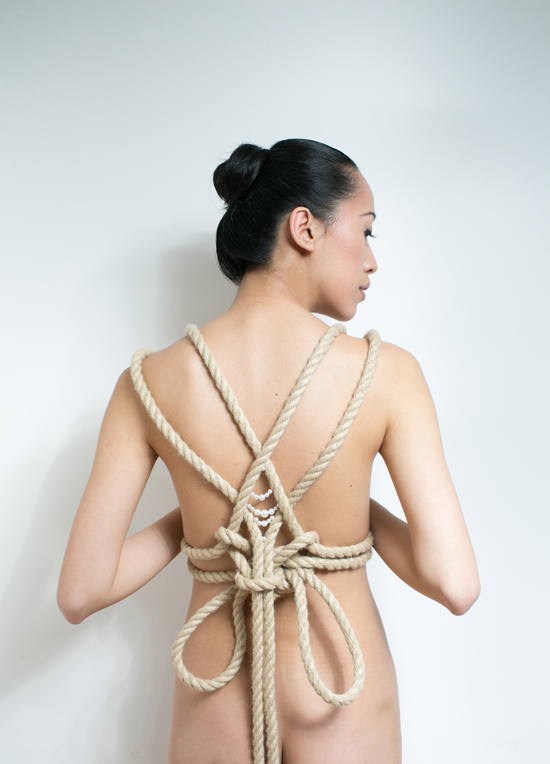
Tell us a little bit about yourself.
My name is Gianna Chan. I enjoy working with pearls and combine them with different types of material to explore new possibilities.
What was the inspiration for this collection?
In my final collection, I mainly use rope to play with the line and knots. The inspiration of my collection is from Japanese Bondage. Japanese bondage involves the interaction between ropes and knots on body to emphasis the body shape of female.
What have you discovered about working with pearls?
The uniqueness of each pearl brings out the differences of individual jewellery. This uniqueness can be differentiated by size, shape and texture etc. Each pearl may lend its character to the design with different settings, like twisting pearls strings to the knots. The roughness of rope and the smoothness of a pearl creates an interesting combination.
What is it that makes a piece of jewellery a design classic?
Historically, there are many paintings that included pearl jewellery. Photographs of Louise Brookes with simple long string of pearls shows an elegance of women that is memorable.
Classic design in jewellery often comes from the combination of using traditional technique with creativity. In my collection, the traditional way of stringing pearls with new expression in rope shows feminine and elegance in a classic style.
What is your most treasured piece of jewellery?
My parents gave me a jade pendant after my birth.
Name one jewellery toolbox essential that you can’t live without.
My hands! Tools are the integrated version of my hands.
IOANNA SOUFLIA
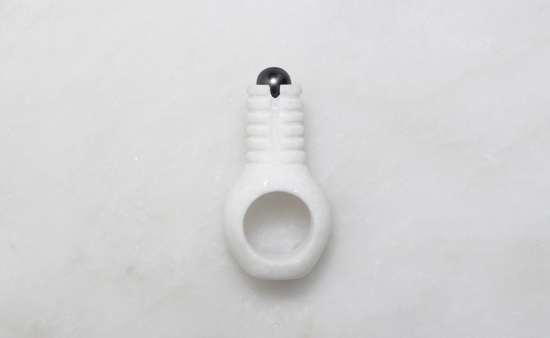
Tell us a little bit about yourself.
I am former law graduate who decided to challenge herself and enter the creative world through jewellery. I am amazed by the infinite possibilities of jewellery design and drawn to the challenge of expressing one self through such an object.
What was the inspiration for this collection?
The starting points for this collection were my contrasting fields of studies: law and jewellery. Contrasting elements; linear patterns and sculptural forms; black and white; contemporary materials such as marble and traditional materials such as metal and the pearl brought together. A synthesis of opposing elements resulting to a cohesive union.
What have you discovered about working with pearls?
The ability of the pearl to stand out but at the same time to adapt to the design; its dual character, a classic, fine jewellery material which can be incorporated to a more contemporary piece of jewellery; for me this is what makes pearls timeless.
What’s next for you after CSM?
My goal after CSM will be to start and establish my own brand.
What is your most treasured piece of jewellery?
My most treasured piece of jewellery would be the first ring I ever made. It signals the beginning of my creative journey in the jewellery world.
What’s your motto?
Be persistent; this is what I have been telling myself from the very moment I decided to become a jewellery designer.
JESSIE SEO
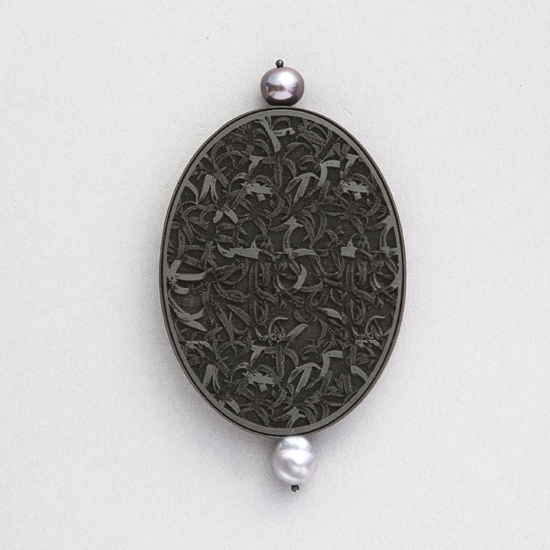
Tell us a little bit about yourself.
I am Jessie Seo. I am a final year student at Central Saint Martins. My designs were derived by my fascination of nature.
What was the inspiration for this collection?
My imagination started when looking at large pieces of dark bark that had really interesting textures. I wanted to manipulate the textures of the wood and explore the depth and texturized images engraved on the wood. The idea of engraving flowers on the wood has been the subject of my fascinatation with the material of wood.
I found an artist named Karl Blossfeldt. His black and white photographs of a flower’s buds, shoots and stems were magnified and their shapes were amazing. I was drawn to the images of his works and inspired me to engrave them immediately on the black ebony wood.
Combining natural material into jewelry gives me an emotion of wearing nature. My collection is a night garden. The beauty of blackness shines through moonlight that gently rests on this night garden. I have used the pearls to picture the moonlight on the black garden.
What have you discovered about working with pearls?
I have discovered that pearls are very delicate and it has very oriental and natural beauty that makes the jewelry’s beauty to its most height.
What’s next for you after CSM?
An MA in Italy!
Name one jewellery toolbox essential that you can’t live without.
Drill bits!
Name your favourite place for design in London.
London Zoo.
JUNKO KURIHARA
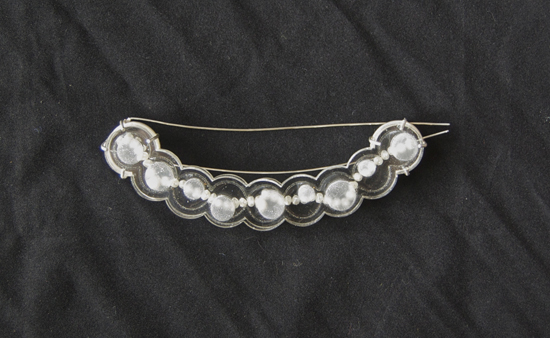
Tell us a little bit about yourself.
I am 23 years old and am from Japan.
What was the inspiration for this collection?
My inspiration came from the blurred images and eyesight, that occurs without wearing contact lenses or glasses.
What have you discovered about working with pearls?
That a natural pearl may have a beautiful colour that people are not able to create.
Who could you imagine wearing your jewellery?
My jewellery is designed for everyone who wants to wear it, but I would imagine particularly for ladies aged 40-50 years old.
What is your most treasured piece of jewellery?
An 18 carat gold ring that I bought with my first salary.
What’s your motto?
Be creative!
-
Central Saint Martins Jewellery 2014 - I
Central Saint Martins Jewellery 2014 - I
For the second year, we have been working with Central Saint Martins, the leading art and design centre based in London.
Our collaboration gives the student designers an opportunity to experience designing with pearls for their final year work, which is showcased at a sparkling Jewellery Awards Evening on 19th June. We will be awarding our Winterson Prize to one of the students for 'The Best Use of Pearls'.
The designs are also open to the public at CSM during June 18-22nd.
Here we feature the first in a four part series of short interviews with designers from the CSM Jewellery 2014 show, including in this article – Eleonora D'Ottavi, Elizabeth Lee, Emma Duckers, Felicia Swartling and Fortuna Weeks.
Read about some of the other designers in Part II, Part III and Part IV of our interviews here. Discover the Winner of the Winterson Prize 2014 here.
ELEONORA D’OTTAVI

Tell us a little bit about yourself.
I am Italian although I have lived both in London and Geneva. In Geneva I became an intern in Christie’s jewellery department where I discovered Fine Jewellery. Since then I have been designing Contemporary/Fine jewellery.
What was the inspiration for this collection?
I wanted to create a collection which would transfer my personality and individuality into pieces of jewellery.
What have you discovered about working with pearls?
While writing my dissertation on the history of pearls I discovered that although natural pearls are incredibly symbolic, freshwater pearls are still without meaning even though they are just as beautiful.
What is it that makes a piece of jewellery a design classic?
I am not sure how to explain this, but there are some pieces of jewellery which make whoever is wearing them radiant, no matter what their age or style (both of the person and jewel). These are what I would consider a classic.
Which designer or artist do you most admire?
JAR
Name one jewellery toolbox essential that you can’t live without.
An antiseptic cream for burns.
ELIZABETH LEE
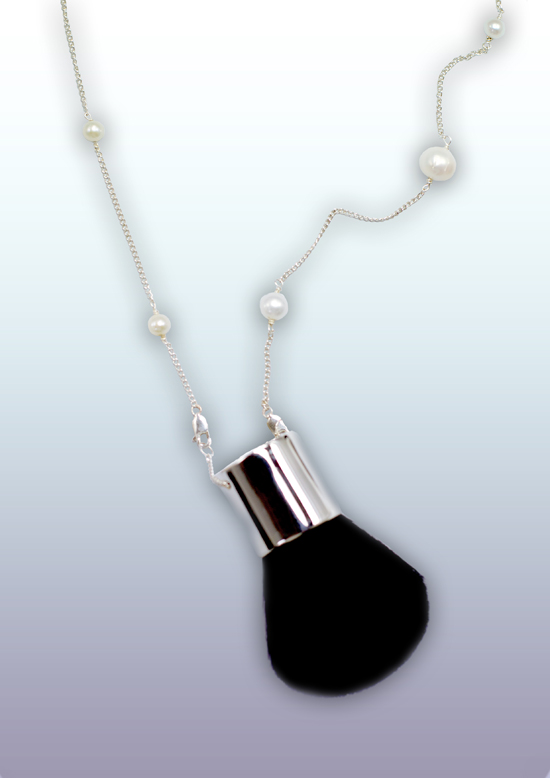
Tell us a little bit about yourself.
I am half Chinese, half Taiwanese, born and raised in London. I have studied at Central Saint Martins since foundation, initially wanting to study fashion design and eventually becoming inspired by jewellery through product design.
What was the inspiration for this collection?
The concept of my collection entitled “Play” is based on the idea of finding the beauty in objects by looking at the finer details we often dismiss. Merging cosmetics into jewellery became the main source of inspiration as the notion surrounding makeup defines play.
What have you discovered about working with pearls?
Pearls come in many sizes and shapes, each having its own unique character and lustre. For a few of my pieces, I worked with inlay and found that the rainbow shine could be reignited with a touch of water to recreate its mesmerizing appearance.
What’s next for you after CSM?
Designing anything product related for a company. Perhaps somewhere abroad!
What is your most treasured piece of jewellery?
A Yves Behar watch. The design is minimal and so innovative and beautiful!
Which designer or artist do you most admire?
Oki Sato for NENDO
EMMA DUCKERS
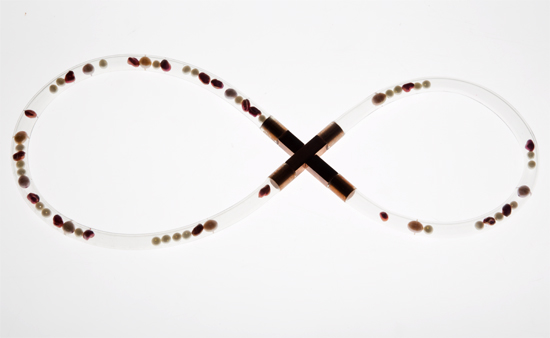
Tell us a little bit about yourself
I am a designer who is looking to alter some of the grey in today’s world.
What was the inspiration for this collection?
The impact of heart disease has been the driving force behind this collection, as it is a matter close to my own heart. This collection is to raise funds for research aimed at conquering Cardiovascular Disease, the biggest killer within the United Kingdom.
There is a focus on the dual aspect of the heart: ‘two pairs of two different kinds of chamber, two types of blood- oxygenated and deoxygenated, red and blue, two sides, two return journeys, two types of vessel: artery and vein; all with a unification in purpose’ (L.Young, The Book of the Heart, 2002).
The series of pearl pieces focuses on the circulation of the blood around the heart. The lathed and milled interlocking sections illustrate the inter workings of the heart, whilst also allowing the neckpieces to have a dual wearability factor. Taking a broad view into a healthy heart, through to the digression experienced with Cardiovascular Disease.
The collection has been informed by the scientific advancements made in the study of the treatment of heart disease up until the present day. It also makes a nod to the fact that this is part of an on-going process. We are not at the end of the road yet and the collection celebrates innovation and advancement as abstract ideas by themselves, whilst also translating into a striking, wearable, considered pieces.
What have you discovered about working with pearls?
Pearls I have found hold the importance of material relevance for my collection, in representing both red, white blood cells and plasma. Relevant from the way they are formed, considered as a natural material and ideal in the array of colours and forms available.
Not only used for their relevance to my concept, yet used in this way the pearls offer an elegant luster, in a considered contemporary design.
Who could you imagine wearing your jewellery?
Melinda Gates.
Which designer or artist do you most admire?
Rebecca Horn for her creative approach to the adornment of the body and spaces.
Name your favourite place for design in London.
The Victoria & Albert Museum hosts an array of inspiration from all over the world under one roof. No matter how many times I visit there is always something new to discover.
FELICIA SWARTLING
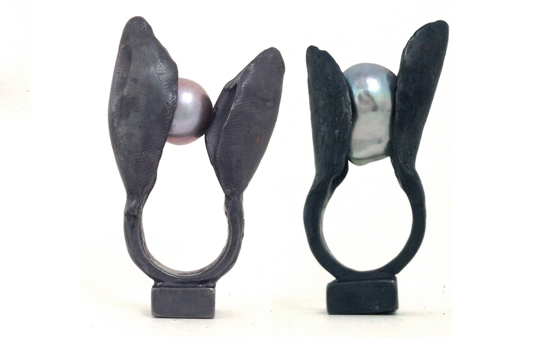
Tell us a little bit about yourself.
My name is Felicia Swartling, I am twenty-four years old and I am obsessed with jewellery. Where my love and hunger for jewellery has grown beyond anything I’ve ever felt before, to the point were Jewellery has to me become more then something that you just wear. It has become a part of me, almost like a language through which I can express myself.
What was the inspiration for this collection?
Similar to the framework of art and fashion, jewellery is also shaped by pre- conceptions that inevitably forms conventional jewellery to be conceived primarily as body adornment. When jewellery is not worn it is placed in a box, drawer or other encapsulating precious container to become invisible and obscured from further admiration. The jewellery box can therefore be seen as a parallel to the invisible space surrounding an exhibition or the stereotyped anonymous body on a catwalk.
With an equivalent shift of perception, my aim is to fuse features from other fields such as sculpture, flowers and African artefacts with jewellery to provoke the pre-conceptions that the conventional framework of jewellery may have.
Through the collection I have designed, I hope the wearer and viewer will re-evaluate the perception of what jewellery is and the value of its use. My collection consists of fifteen independent pieces of jewellery. Each piece has a dual quality; the ability to be worn, yet simultaneously does not require a body to be complete. The pieces have a sculptural quality to inhabit a space so to make the physical body irrelevant when they are displayed.
What have you discovered about working with pearls?
To work with pearls was a new experience and I’m now under their spell and intend to incorporate pearls in more upcoming collections.
What is it that makes a piece of jewellery a design classic?
Primal elements combined with futurism.
A design classic is something that possesses features from its history and tradition, yet fused with futuristic elements that when combined strikes as a contemporary piece with subtle connotations of heritage awareness.
What’s your motto?
No compromises. Shut up and work.
FORTUNA WEEKS
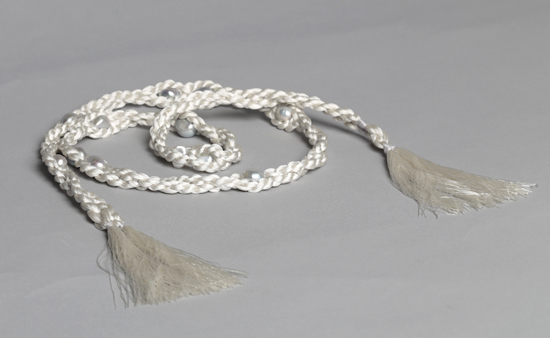
Tell us a little bit about yourself.
I was born in Cuba and raised in New York City. I danced professionally and taught Pilates whilst living in NYC. After relocating to London I became fascinated by the creative buzz that surrounded me and decided to pursue a BA in Jewellery Design at CSM.
What was the inspiration for this collection?
Two contemporary artists inspired me: Yeon Joo Ham, a Korean textile artist; and Jose Parla, a Cuban/American painter. Their pieces brought to mind the interconnection of threads.
I taught myself a selection of complex braids using the ancient art of Japanese braiding, Kumihimo. Whilst braiding I found that I could relate the sound and rhythm of the bobbins knocking against the loom to the natural cycles in nature, such as Water. My collection is based on all these ingredients.
What have you discovered about working with pearls?
They feel great, they are timeless, and I love the lustre of good quality pearls. They are beautiful and work well with my collection.
What is it that makes a piece of jewellery a design classic?
A piece of jewellery is a design classic when it possesses timeless aesthetic value. It can be worn and appreciated regardless of when it was made.
What is your most treasured piece of jewellery?
My mother’s bracelets. Their family history, craftsmanship and beauty make them a design classic.
Name your favourite place for design in London.
My favorite place for design is the Saatchi Gallery.
-
The Glamour of Italian Fashion
The Glamour of Italian Fashion
Opening this weekend is the V&A's major Spring show, 'The Glamour of Italian Fashion 1945-2104'.
Charting the rise of Italian fashion over the last 70 years, the exhibition follows the pivotal events, production innovations and individuals that have created an industry feted today for its glamour, sophistication and luxury.
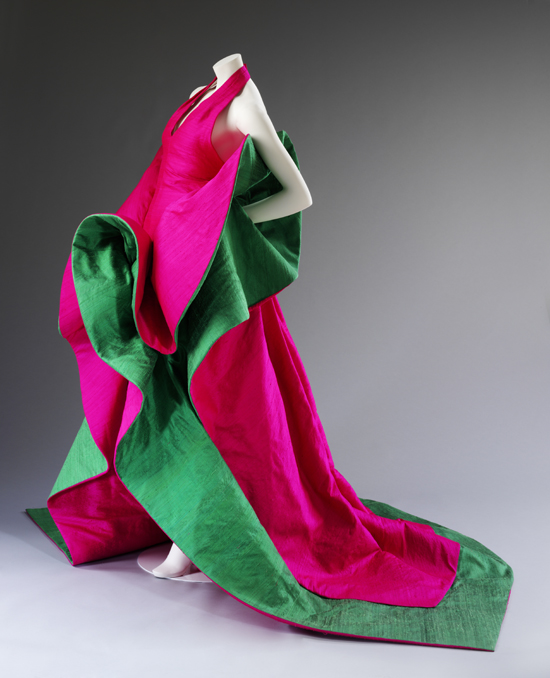
The curator of the exhibition, Sonnet Stanfill who is also curator of 20th century and contemporary fashion at the V&A, has drawn together over 100 ensembles and accessories by many of Italy's famous fashion houses.
Visitors to the exhibition can admire the elegance and seductive style of Valentino, Prada and Armani, the intricacy of knitwear by Missoni, and fine leatherwork by Dolce & Gabbana and Gucci.

For jewellery lovers there will also be a rare opportunity to view the sheer opulence of a private collection of Bulgari jewels.
As more films were being shot on location in Italy during the 1950s and 1960s, Hollywood stars such as Audrey Hepburn and Elizabeth Taylor became style icons for Italian fashion. The American market, in particular, began to take note.
Taylor's husband Richard Burton even famously quipped 'the only word Liz knows in Italian is Bulgari'.
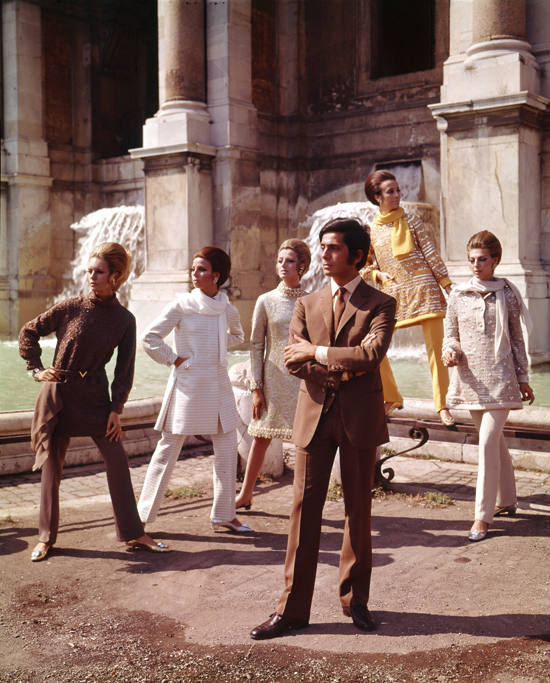
Rather than just being an amazing roll call of today's international design labels, the exhibition also offers the visitor a unique perspective in its examination of these early years.
In preparing the exhibition, Curator Stanfill has carefully researched the world of the Sala Bianca, pictured above, which is often regarded as the post-war birthplace of Italian fashion.
The Sala Bianca was the dream of an Italian business man called Giovanni Battista Giorgini who, whilst exporting Italian-made luxury goods to America, saw an opportunity to promote Italian artisanship and style. A gentleman, without profiting personally from the initiative, Giorgini was also a marketing genius.
Hiring crystal chandeliers, catwalk models and the surroundings of the famous Pitti Palace in Firenze, Giorgini introduced the Italian fashion industry to the world within just a few successful seasons.
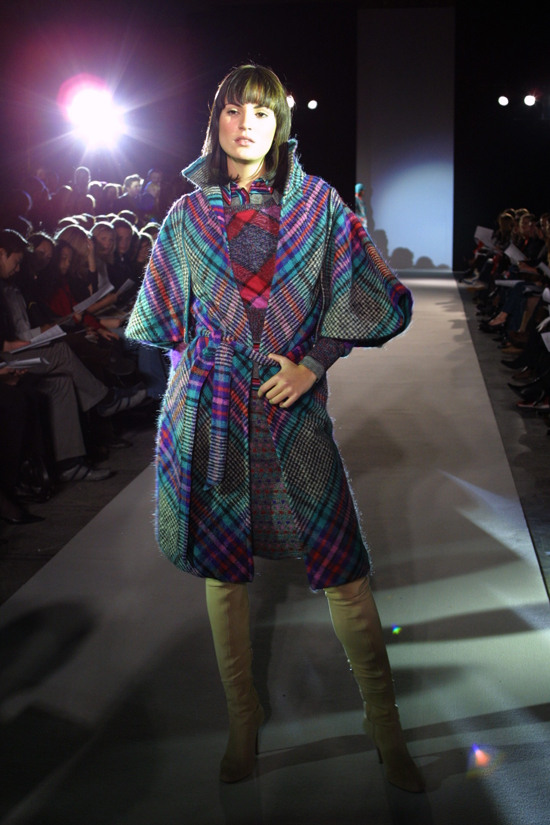
The exhibition finishes with a video debate on the future of Italian fashion and questions its role in a world of overseas production and fast-fashion.
Promising to be a thought-provoking and affectionate look at the status of 'Made in Italy' today, the 'Glamour of Italian Fashion 1945-2014' opens on 5th April until 27 July 2014 at the V&A, London.
-
Mystery Surrounds The Cheapside Hoard
Mystery Surrounds The Cheapside Hoard
Mystery still surrounds the jewels of the Cheapside Hoard. Why were these striking jewels originally buried deep beneath the cellar of a building in London's Cheapside and what was the purpose of many of the objects that the Hoard contained?
The Cheapside Hoard was discovered in 1912, the most significant find of its kind, during the redevelopment of Cheapside, a medieval street between modern day St. Paul's Cathedral and Bank. This bustling market route was famously described by Charles Dickens Jr. as "the greatest thoroughfare in the City of London".

The exhibition's curators can be relatively accurate about the date that the Cheapside Hoard was originally buried. The particular style of the jewels and the date of the Great Fire of London that flattened much of the area around Cheapside, bookends the Hoard being buried during a decade that was approximately between 1650-1666.

Given the repetition of a number of similar styles and ideas throughout the collection - numerous carved grapes in amethyst and emerald, ropes of enamelled floral chains - it does seem that the owner might have been a jeweller or dealer, perhaps from nearby Goldsmiths' Row. The Hoard clearly pinpoints the fashions of the day in a way that the collection of an individual might not.

Currently on show at the Museum of London in its entirety for the first time in a century, there are just a few pearls in the Hoard that have survived the four hundred years since the pieces were first hidden away. The myriad empty settings that remain - the curators estimate approximately 1,386 were intended for pearls - are testament to the gem's enduring appeal.
Of those on display, the pieces crafted from fine gold wirework, encasing sheets of back-to-back mother of pearl (most now sadly lost), are captivating. Designed in the shape of what the curators describe as "the translucent seed pods of the plant Lunaria, regarded as a symbol of honesty and appreciated for its healing properties," it is not clear that the items were ever intended for wear.

Mother of pearl was more commonly found in inlay work at this time, and the scale of the pieces precludes them being worn as earrings. However, the enamelled four-petalled cross that links the fifth drop to the main four petals would have given the gems a lovely movement, and had the mother of pearl itself been engraved, as the curators suggest the material often was, these pieces would have been quite beguiling.
The combination of enamel and seed pearls (a chain of which in the Hoard has settings for over 500 pearls with only 7 remaining) was popular in London at this time, a trend which Winterson's Beau collection designed by Alice Cicolini in some part echoes.
Seed pearls also appear on delicate wirework buttons that would have required a high level of craftsmanship for these to be realised.
Of the striking pearls of the Cheapside Hoard that have survived the centuries, the most notable are a baroque pearl carved into the shape of a ship, complete with wirework mast and rigging, and an 11mm pearl with a deep "orient lustre" that sits above a figuratively carved sapphire.

As with many other gems, a pearl of "oriental origin" commanded a high price during the period, the term being used to imply quality as much as provenance. Londoners in the 1600s, the curators believe, were particularly fussy about the quality of their pearls, with even high grade pearls going unsold if they were not of the correct colour and radiant lustre.
At Winterson, where great care is also taken to identify the finest quality pearls to make up our jewellery, we tend to agree!
The Cheapside Hoard: London's Lost Jewels is exhibiting at the Museum of London until 27th April.
-
The Friday Late Rules of Adornment
The Friday Late Rules of Adornment
The regular Friday Late event at the V&A this week features The Rules of Adornment, an evening of workshops, films and performances exploring the question of why we choose to wear what we do.
Inspired by the V&A and Qatar Museums Authority's current Pearls exhibition, this popular regular event promises to mix guest DJs with fashion and graphic design, as well as presentations and installations on music, tattoos and jewellery.

Amongst the events exploring the links between adornment, status and personal expression are a number that are related to pearls. Here is our selection:
18.30-21.30, a drawing-based workshop by artist Ben Barbour on the history of the pearl trade routes;
19.00-20.00, Pearl Editions by students at Central Saint Martins. As a follow-up to their Pearl Variations project, BA Jewellery students from CSM have created a series of limited edition collections for the evening that pushes the possibilities of pearls as adornment;
20.00, a conversation by Pearls curator Beatriz Chadour-Sampson and Qatar National Museum Heritage expert Dr Najla Ismail into the myths, symbolism and fashion of pearls.
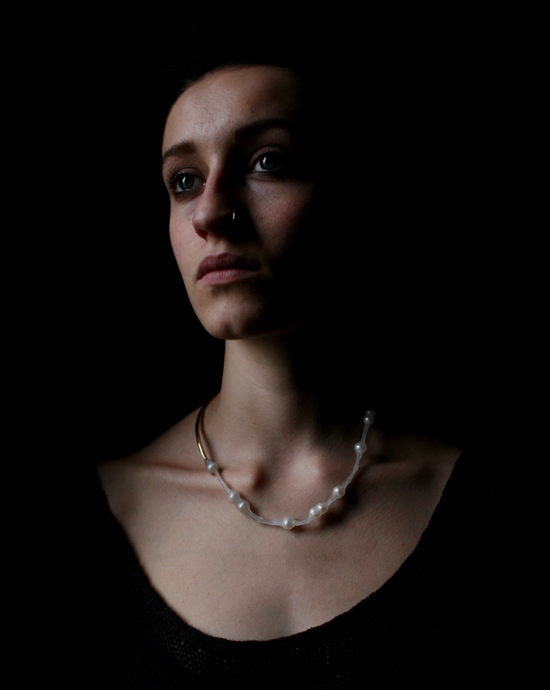
There are many other events during the evening in the main hall and throughout the museum itself. Or if you would like to acquire a hand-drawn tattoo, or even to learn how King George V acquired his, then this is the event for you.
The Museum is open late to the public on Friday 29th November until 22.00. All Friday Late events are free, although some places may be ticketed on a first come first served basis.
-
The CSM Pearl Variations Project At The V&A
The CSM Pearl Variations Project At The V&A
Earlier this year, we were privileged to take part in Pearl Variations, a collaborative project between the first year BA Jewellery students at Central Saint Martins (CSM) and the Victoria and Albert Museum, London.
To coincide with the opening of the V&A and the Qatar Museums Authority Exhibition on Pearls, the students were invited to explore the history of this gem and the possibilities that new ideas and creativity might bring to pearl jewellery design.
Each student was encouraged to produce a collection or theme of work, with the opportunity for three pieces to be selected for sale in the V&A Shop - an exciting prospect for any aspiring jewellery designer!
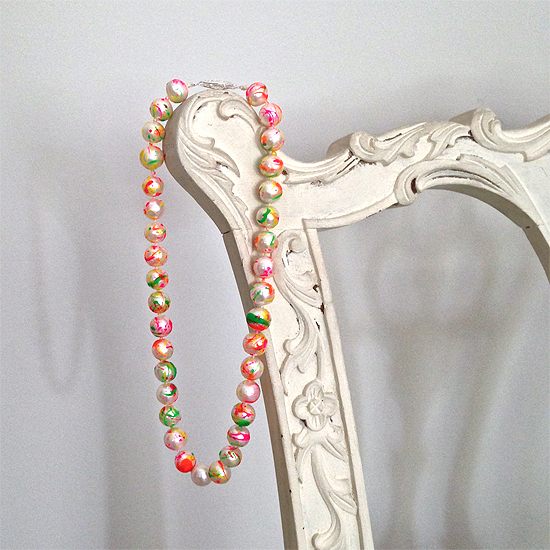
Following an introduction to the exhibition by one of its curators Beatriz Chadour-Sampson, the students embarked on developing their ideas.
Alongside a senior buyer from the V&A, we attended two reviews in March and June to give some specialist pearl feedback on the work-in-progress.
Looking back at the notes from those sessions, it is fantastic to see how the students' work progressed throughout the project.
Lili Murphy Johnson's Brace-let (pictured above) was inspired by the phrase 'pearly white teeth'. The original design using orthodontic steel braces and pearls to give the impression of a dental brace of real teeth was carried through brilliantly.
There were many other stand-out ideas in the group. Harriet Williams' vibrantly painted pearls (also above) played with notions of value and colour, whilst Danya Xie's ebony pearl ring was one of our favourites. An elegant contrast of materials, colour and texture created a ring that would be endlessly turned on the wearer's finger.

During the period of the exhibition until 19 January 2014, each of the pieces above are on sale in person and online at the V&A Shop.
Our thanks go to the students, Giles Last at CSM and the V&A for the realisation of this unique project.
-
SS14 Jewellery and Pearls at the Rock Vault
SS14 Jewellery and Pearls at the Rock Vault
With September quickly fading into the Autumn, we look back to some of the SS14 jewellery and pearls that excited our attention this season at London Fashion Week.
Rock Vault, curated by jeweller Stephen Webster, is a showcase of ten of the most talented designers working in the UK. The initiative is into its fourth season and a perfect opportunity for press and buyers alike to see the group's new collections.
ALICE CICOLINI
Alice Cicolini's colourful new Kimono Collection, explores traditional patterns within circles and using her trademark enamelling techniques. The Kimono pieces mix vitreous enamel with vintage hand cut diamonds, polished opals and some truly fabulous pearls!

Our forthcoming Beau collection with Alice Cicolini, was also on show for the first time. We are very excited to be launching it at Winterson soon.
MELANIE GEORGACOPOULOS
Contemporary designer Melanie Georgacopoulos is admired for challenging traditional notions of what pearls mean in today's world.
Her previous work has included splitting cultured pearls in half to reveal the concentric layers of nacre inside and drilling pearls from the inside out to leave a skeletal shell of its surface.
Previewing her new SS14 for M/G Tasaki, a collaboration with the Japanese fine jeweller, Melanie's collection featured white Freshwater pearls and stretched 18 carat gold chain. We loved the inventiveness of this ring.
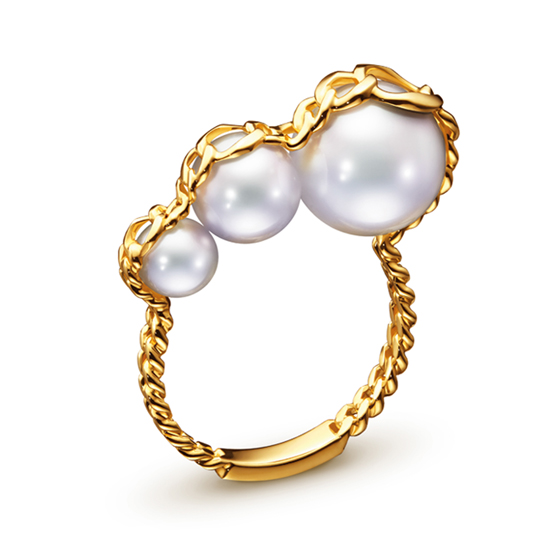
Also on show was Melanie's new fine jewellery line of necklaces, pendants and earrings, exploring the relationship between pearls and diamonds that have been set in cages of 18 carat gold.
ORNELLA IANNUZZI
A welcome addition to the Rock Vault this September was Ornella Iannuzzi's coral fantasy pieces, which set a variety of colourful Freshwater and Tahitian pearls in gold and silver forms that have been inspired by nature.
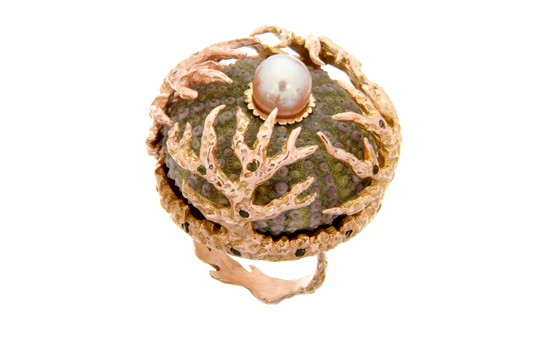
Ornella Iannuzzi is best known for her sculptural, organic jewellery that is created by hand in her London studio, such as the fabulous Abyss ring above.
Launching at LFW for SS14 was Les Corallines, a new everyday wear range that continued the volcanic, underwater theme with silver and gold vermeil pieces and these baroque saltwater Tahitian pearls.
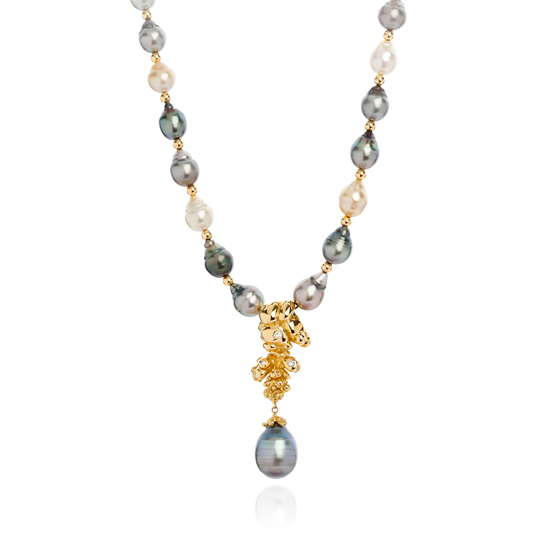
-
A Peek at the Pearls of Carl Linnaeus
A Peek at the Pearls of Carl Linnaeus
The world of pearls can hold many surprises, but it is not everyday that you have an opportunity to view a historic treasure secured safely beneath the streets of London.
The experimental pearls of famed Swedish botanist Carl Linnaeus are about to join the forthcoming Pearls Exhibition at the V&A and so we jumped at the chance to see these early successful attempts to culture a spherical pearl in close up.
CARL LINNAEUS
Carl Linnaeus (1707-1778) is best known for his method of classifying organisms that uses two latin names to represent the genus and the species, for example 'Homo Sapiens'. This taxonomy is conventionally used today to describe and classify the hierarchical relationships of animals, plants and insects to each other.
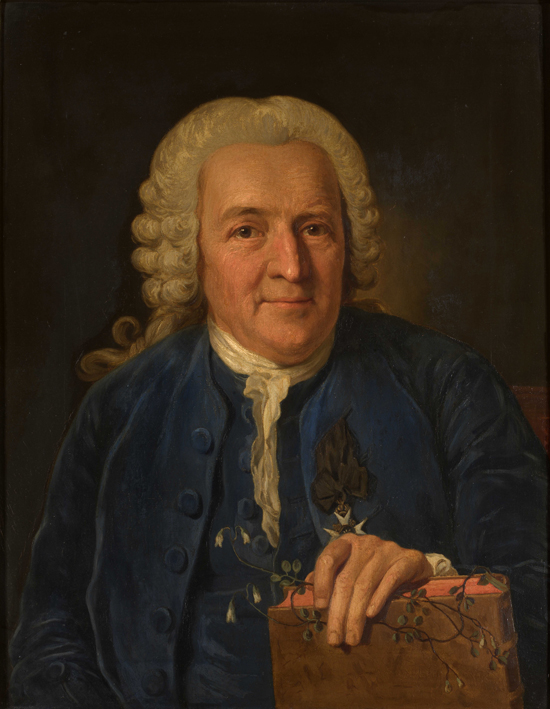
Linnaeus' collections of specimen organisms, including dried flowers, insects, fish and molluscs are unique and are still a primary reference point for scientists to determine if they have found a new species.
Following his death, the Linnean collections were purchased by Sir James Edward Smith in 1784 and transported to London, where they remain today.
THE LINNEAN SOCIETY
In 1788, Smith also founded The Linnean Society to provide a forum to discuss and promote the study of natural history.
The Linnean Society is the world's oldest active biological society. It was at a meeting of the Society in 1858 that papers by Charles Darwin were presented outlining the theory of natural selection and evolution.
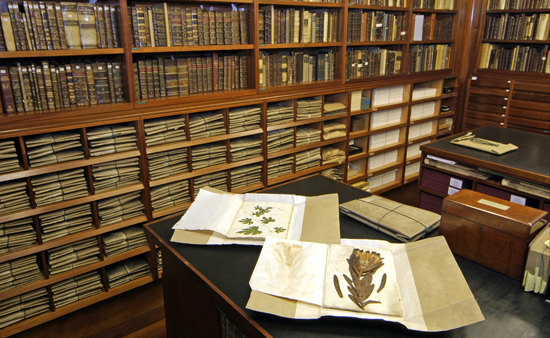
The collections were obtained by the Society in 1829 and are today securely held in a vault below the courtyard of Burlington House, Piccadilly in central London. Leather bound books, old parchment folders and specimen trays line the carefully curated shelves and drawers.
Also in the strongroom was a very rare (and valuable) signed first edition of Charles Darwin's 'Origin of the Species' - a once-in-a-lifetime opportunity to see.
LINNAEA BOREALIS
Carefully wrapped in parchment was this original specimen of Linnaea Borealis, a wildflower of northern and alpine origin that has a distinctive double twin flower shape. The flower is named after Linnaeus as it was a favourite of his whilst travelling in Lapland.
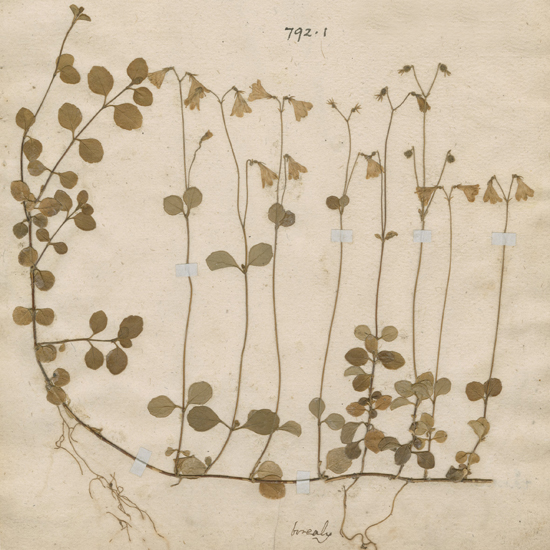
As well as having a beautiful white pink flower, Carl Linnaeus fell in love with the wildflower for the way that it grew persistently in the undergrowth and its ephemeral, short-lived life. These were two symbols that he felt were important in his own life and portraits of Linnaeus, including the one above, and in the Society all feature the Linnaea Borealis.

This little flower has a special meaning for Winterson as it was an inspiration for our own flower motif, also honouring its link with Linnaeus and his early achievements in culturing pearls.
LINNAEUS AND PEARLS
Linnaeus declared in 1761 that 'he had heard of people who made gold, but had never heard of any who could make pearls'. Describing the lengthy and time-consuming efforts to find natural pearls that he had seen in Purkijaur, Lapland, Linnaeus believed that a technique for culturing pearls existed that would be more effective and profitable for Sweden.
Linnaeus started to experiment with 'Unio Pictorum', a species of freshwater mussel called the Painter's mussel. This mussel was named as traditionally its shells were used by painters as convenient receptacles for mixing paint.
His technique was a variation of an old Chinese method for producing blister pearls. Drilling a hole in the mussel's shell, Linnaeus inserted a small granule of limestone between the mantle and the shell to help produce a free spherical pearl inside the mussel.

The mussels were returned to the riverbed for six years to produce what is regarded as the world's first spherical cultured pearls. They are indeed historic and fascinating to view.
Linnaeus' method is also based on an old misunderstanding that pearls are created with a grain of sand. We know now that a response to illness or a parasite is the more likely explanation for the growth of natural pearls in an oyster or mussel.
These experimental pearls were not ultimately the source of riches that Linnaeus had hoped for, but he was enobled by the King of Sweden for his efforts taking the title von Linné. The pearls, a patent and Linnaeus' secret were sold to a Swedish merchant named Peter Bagge, but nothing came out of this venture.
Another Londoner Sir John Hunter is recorded as having attempted to culture freshwater pearls in his ponds at Earl's Court Manor House using a similar method to Linnaeus, but it was left to a different Englishman William Saville-Kent to make the next break-through in pearl culturing.
SEE THE LINNAEUS PEARLS AT THE V&A
We would to like thank Elaine Charwat, Deputy Librarian of the Linnean Society for her fabulous help in showing us Carl Linnaeus' pearls.
The pearls themselves are on display soon at Pearls, the V&A's new exhibition. Not to be missed...